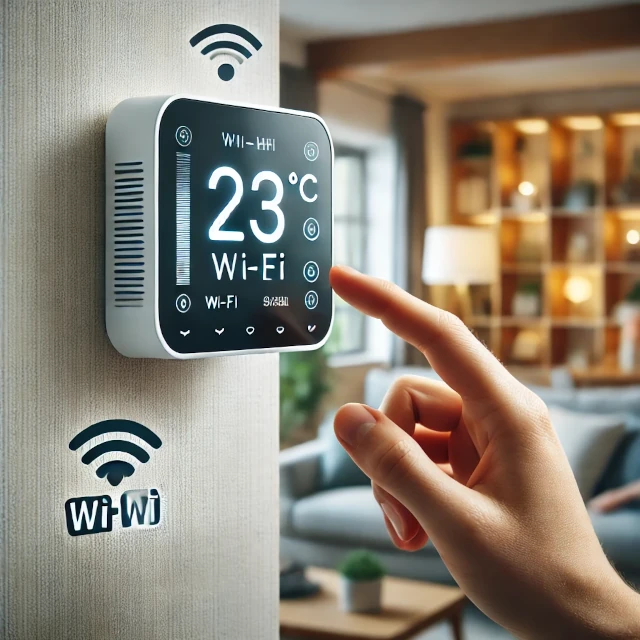Smart thermostats have become an essential part of modern homes, offering energy efficiency, remote access, and automation. However, one common issue many users experience is a slow response from their smart thermostat. Whether it takes too long to adjust the temperature, doesn’t follow scheduled settings promptly, or seems unresponsive, these problems can be frustrating.
If your smart thermostat is slow to respond, there are several possible causes, including Wi-Fi connectivity issues, outdated firmware, sensor malfunctions, and more. In this guide, we will walk you through step-by-step troubleshooting methods to identify and fix slow response times on your smart thermostat.
Understanding the Importance of a Smart Thermostat
Before diving into troubleshooting, it’s essential to understand the role of a smart thermostat. These devices help regulate your home’s temperature efficiently by learning your habits, optimizing heating and cooling schedules, and providing remote access via smartphone apps.
However, if a thermostat becomes sluggish, it may compromise energy savings, comfort, and automation. Ensuring that your thermostat operates smoothly is crucial for maintaining an optimal indoor environment while reducing energy costs.
Common Causes of a Slow-Responding Smart Thermostat
Several factors could be responsible for your smart thermostat’s slow response. Let’s explore the most common reasons:
1. Weak or Unstable Wi-Fi Connection
Smart thermostats rely on an internet connection to communicate with cloud servers and mobile apps. If your Wi-Fi signal is weak, there can be a noticeable delay in response times.
2. Outdated Firmware or Software Bugs
Running an outdated software version can slow down your thermostat’s performance and introduce bugs that impact its functionality.
3. Temperature Sensor Issues
The thermostat depends on sensors to detect temperature changes. If the sensors are dirty, misaligned, or malfunctioning, they can slow down response times.
4. HVAC System Delays
Some heating and cooling systems have built-in delays to prevent short cycling, which might make it seem like the thermostat is slow to respond.
5. High Network Traffic
Too many connected devices on your Wi-Fi network can overwhelm your router, leading to slower response times for your smart thermostat.
6. Power Supply Issues
Low battery levels (for battery-powered models) or power fluctuations can interfere with performance.
7. Improper Placement of the Thermostat
If your thermostat is placed near heat sources, windows, or vents, it may misread temperature data and cause delayed responses.
Step-by-Step Fixes for a Slow Smart Thermostat
Step 1: Check and Optimize Wi-Fi Connection
Since smart thermostats depend on a stable internet connection, checking your Wi-Fi should be your first troubleshooting step.
How to Fix It:
- Test Your Internet Speed: Use an internet speed test app on your phone near the thermostat. If your speed is below 5 Mbps, your thermostat might be experiencing delays.
- Restart Your Router: Unplug your router, wait for 30 seconds, and plug it back in to refresh the connection.
- Improve Signal Strength: Move your router closer to the thermostat or use a Wi-Fi extender to boost coverage.
- Reduce Network Congestion: Disconnect unused devices to free up bandwidth for your thermostat.
Step 2: Update Firmware and Mobile App
Software updates often fix bugs and improve the thermostat’s performance.
How to Fix It:
- Open the thermostat’s mobile app and check for firmware updates.
- Install any available updates and restart the thermostat.
- Update the companion mobile app from the App Store or Google Play.
Step 3: Inspect and Clean Temperature Sensors
If your smart thermostat takes too long to adjust the temperature, faulty sensors may be the issue.
How to Fix It:
- Gently clean the thermostat’s sensors using a microfiber cloth.
- Ensure external temperature sensors are securely connected and unobstructed.
- If the thermostat is located in a poor position, relocate it to an optimal spot away from heat sources and drafts.
Step 4: Adjust HVAC System Delays
Some HVAC systems incorporate built-in delays to protect the equipment. However, these delays can make it seem like your thermostat is slow to respond.
How to Fix It:
- Check the thermostat’s settings for adjustable delay options.
- If your HVAC system has a manufacturer-imposed delay, consult an HVAC technician about possible modifications.
Step 5: Power Cycle the Thermostat
Restarting the thermostat can resolve software glitches and improve response times.
How to Fix It:
- Remove the thermostat from its wall mount and disconnect it from power.
- Wait for two minutes before reconnecting it.
- Restart your HVAC system if necessary.
Step 6: Optimize Your Home Network Performance
Your thermostat’s connection may be slow due to high network traffic.
How to Fix It:
- Upgrade to a dual-band router to separate smart devices from other internet-connected devices.
- Set up a dedicated Wi-Fi network for smart home devices.
- Use an Ethernet connection for high-bandwidth devices to free up Wi-Fi resources.
Step 7: Replace or Recharge Batteries
For battery-powered smart thermostats, low power can slow down operations.
How to Fix It:
- Check battery levels in the thermostat’s settings menu or mobile app.
- Replace old batteries with fresh ones or recharge if applicable.
Step 8: Reset the Thermostat to Factory Settings
If all else fails, resetting the thermostat to its default settings can eliminate software errors and improve response times.
How to Fix It:
- Open the settings menu on the thermostat or app.
- Select “Factory Reset” or “Reset to Default.”
- Reconfigure the thermostat according to setup instructions.
Step 9: Seek Professional Help
If your thermostat continues to respond slowly despite troubleshooting, it could be due to a hardware issue or an HVAC system malfunction.
What to Do Next:
- Contact the thermostat’s manufacturer for support and possible warranty service.
- Schedule an inspection with an HVAC professional to check for underlying system issues.
Preventive Measures for a Responsive Smart Thermostat
To avoid future slow response issues, follow these preventive maintenance tips:
- Regularly clean thermostat sensors to ensure accurate temperature readings.
- Keep the firmware updated to receive the latest performance improvements.
- Optimize Wi-Fi placement and reduce network congestion for a stable connection.
- Replace batteries promptly or ensure reliable power supply.
- Position the thermostat in an ideal location, away from heat sources or direct sunlight.
Final Thoughts
A sluggish smart thermostat can be frustrating, but by systematically addressing connectivity, software, sensor, and HVAC issues, you can restore its efficiency. Keeping your device well-maintained and optimizing its settings will help it function smoothly, ensuring a comfortable and energy-efficient home environment.
By implementing these troubleshooting steps and preventive measures, you can maximize the performance of your smart thermostat and enjoy seamless temperature control.
Have you experienced a slow response time with your smart thermostat? Share your experience and solutions in the comments below!
You might also like,

